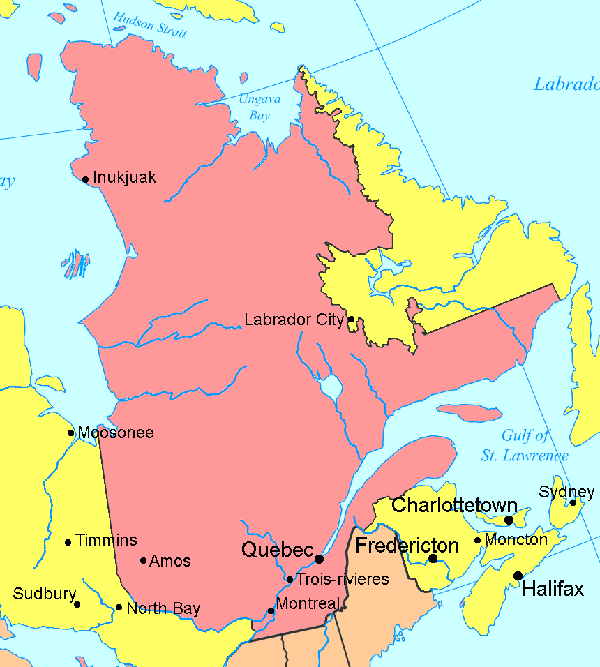|
Quebec
Quebec is the largest province in Canada geographically, and the second most populous, after Ontario, with a population of 7,568,640 (Statistics Canada, January 2005). This represents about 24% of the Canadian population. Quebec's primary and only official language is French, making up the bulk of the Francophone population in North America. Quebec is the only Canadian province where English is not an official language, and it is one of only two Canadian provinces where French is an official language (the other one being New Brunswick). The capital is Quebec City (simply referred to as "Québec" in French) and the largest city is Montreal (or Montréal in French). A resident of Quebec is called a Quebecer (also spelled Quebecker), or in French, un(e) Québécois(e). The name Quebec, which comes from the Mi'kmaq word Gepèèg meaning "strait," originally meant the narrowing of the St. Lawrence River off what is currently Quebec City. The first European explorer of what is now Quebec was Jacques Cartier, who planted a cross in the Gaspé in 1534 and sailed into the St. Lawrence River in 1535. Quebec City was founded near the site of Stadacona, a village populated by Iroquoians when Jacques Cartier explored Canada. However, the village was no longer there when Samuel de Champlain established the Habitation de Quebec in 1608. After 1627, King Louis XIII of France introduced the seigneurial system and forbade settlement in New France by anyone other than Roman Catholics, ensuring that welfare and education was kept firmly in the hands of the church. New France became a royal province in 1663 under King Louis XIV of France and the intendant Jean Talon. Great Britain acquired Canada by the Treaty of Paris (1763) when King Louis XV of France and his advisors chose to keep the territory of Guadeloupe for its valuable sugar crops instead of New France, which was viewed as a vast, frozen wasteland of little importance to the French colonial empire. By the British Royal Proclamation of 1763, Canada (part of New France) was renamed the Province of Quebec. In 1774, the British Parliament passed the Quebec Act that helped ensure the survival of the French language and French culture in the region. The Act allowed Quebec to maintain the French civil law as its judicial system and sanctioned the freedom of religious choice, allowing the Roman Catholic Church to remain. Quebec retained its seigneurial system and civil law code after France's giving of the territory to England. Owing to an influx of Loyalist refugees from the US Revolutionary War, the Constitutional Act of 1791 saw the colony divided in two at the Ottawa River (a small portion west of the Ottawa/St. Lawrence River confluence, which had the westernmost seigneuries, was retained in Lower Canada); the western part became Upper Canada and changed to the British legal system. The eastern part was named Lower Canada. In 1837, after the government had allowed the French Canadians to be represented in the House of Commons, some residents of Upper Canada launched a rampage through the western part of the Lower Canada. They did not think that the French population would take part so actively in the new government and would therefore ask for a more fair and respectful House of Commons. The residents of Lower Canada then formed a group of resistance, called the Patriotes, but were soon crushed by the British army after only one victory in Saint-Denis, south of Montreal. After the Patriotes Rebellion of 1837, the British government merged the Canadas into one Province of Canada in 1841. However, the union proved contentious. In 1867 the Province of Canada, joining with the other British colonies of New Brunswick and Nova Scotia in the Canadian Confederation, was redivided into its two parts, under the names Ontario and Quebec. The conservative government of Maurice Duplessis and his Union Nationale dominated Quebec politics from 1944 to 1960 with the support of the Catholic church. Pierre Trudeau and other intellectuals and liberals formed an intellectual opposition to Duplessis' repressive regime setting the groundwork for the Quiet Revolution under Jean Lesage's Liberals. The Quiet Revolution was a period of dramatic social and political change that saw the decline of the Roman Catholic Church's influence, the nationalization of Hydro-Québec and the emergence of a separatist movement under former Lesage minister René Lévesque. During the 1960s, a terrorist group known as the Front de libération du Québec (FLQ) launched a decade of bombings, robberies and attacks on government offices. Their activities culminated in events referred to as the October Crisis when James Cross, the British trade commissioner to Canada, was kidnapped along with Pierre Laporte, a provincial minister and Vice-Premier, who was murdered a few days later. In response, Prime Minister Pierre Trudeau declared martial law using the War Measures Act. A Federal government inquiry later revealed that under Prime Minister Pierre Trudeau's demand, some Royal Canadian Mounted Police (RCMP) agents infiltrated the group and pushed them towards terrorist actions in order to gain evidence of the group's willingness to commit terrorist acts. In 1977, the newly elected Parti Québécois government of René Lévesque introduced the Charter of the French Language. Often known as "Bill 101", it defined French as the only official language of Quebec and is to this day still controversial and widely misunderstood inside and outside Quebec by the English speaking population. Lévesque put sovereignty-association before the voters in the 1980 Quebec referendum. Sixty percent of the Quebec electorate voted against it. On October 30, 1995, in a second referendum the vote for Quebec independence was rejected by a slim majority (50.6% NO to 49.4% YES). |
||||||||||
